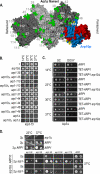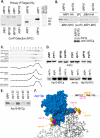Arp10p is a pointed-end-associated component of yeast dynactin
- PMID: 16291862
- PMCID: PMC1356584
- DOI: 10.1091/mbc.e05-05-0449
Arp10p is a pointed-end-associated component of yeast dynactin
Abstract
In metazoans, dynein-dependent vesicle transport is mediated by dynactin, containing an actin-related protein, Arp1p, together with a cargo-selection complex containing a second actin-related protein, Arp11. Paradoxically, in budding yeast, models of dynactin function imply an interaction with membranes, whereas the lack of microtubule-based vesicle transport implies the absence of a cargo-selection complex. Using both genetic and biochemical approaches, we demonstrate that Arp10p is the functional yeast homologue of Arp11, suggesting the possible existence of a pointed-end complex in yeast. Specifically, Arp10p interacts with Arp1p and other dynactin subunits and is dependent on Arp1p for stability. Conversely, Arp10p stabilizes the dynactin complex by association with the Arp1p filament pointed end. Using a novel hRAS-Arp1p one-hybrid assay, we show that Arp1p associates with the plasma membrane dependent on dynactin subunits, but independent of dynein, and sensitive to cell wall damage. We directly show the association of Arp1p with not only the plasma membrane but also with a less dense membrane fraction. Based on the hRAS-Arp1p assay, loss of Arp10p enhances the apparent association of dynactin with the plasma membrane and suppresses the loss of signaling conferred by cell wall damage.
Figures






References
-
- Belli, G., Gari, E., Aldea, M., and Herrero, E. (1998a). Functional analysis of yeast essential genes using a promoter-substitution cassette and the tetracycline-regulatable dual expression system. Yeast 14, 1127-1138. - PubMed
-
- Broder, Y. C., Katz, S., and Aronheim, A. (1998). The ras recruitment system, a novel approach to the study of protein-protein interactions. Curr. Biol. 8, 1121-1124. - PubMed
Publication types
MeSH terms
Substances
Grants and funding
LinkOut - more resources
Full Text Sources
Molecular Biology Databases
Research Materials
Miscellaneous

